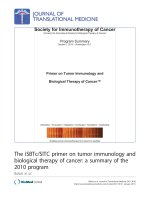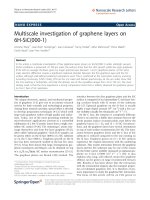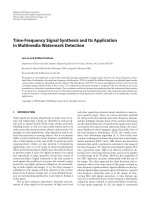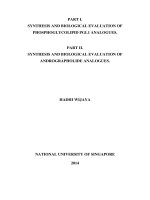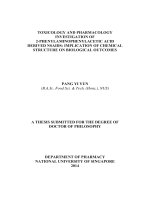Synthesis and biological investigation of pyrimido,1,2 a ,1,3,5,triazine and its analogues 1
Bạn đang xem bản rút gọn của tài liệu. Xem và tải ngay bản đầy đủ của tài liệu tại đây (2.39 MB, 143 trang )
Chapter 1 INTRODUCTION
Nitrogen containing heterocycles are of immense importance biologically and
industrially1. The triazines are among the oldest known organic nitrogen-containing
heterocycles that possess three ‘N’ atoms in a six membered ring. They may exist in
three possible isomeric forms namely 1,2,3-triazine, 1,2,4-triazine and 1,3,5-triazine
(Fig. 1).
N
N
N
1,2,3
-triazine
N
N
N
N
1,2,4
-triazine
N
N
1,3,5
-triazine
Fig. 1 Isomeric forms of triazine (C3H3N3).
In the literature, there are many anticancer agents that possess the 1,3,5-triazine
heterocycle. Many of them are being used in the clinic and some are undergoing
clinical trials (Fig. 2). HMM (Hexamethylmelamine) is a substituted 1,3,5-triazine
derivative which is used clinically as an alkylating anti-neoplastic agent for the
treatment of ovarian cancer2. A190 is a dihydrotriazine derivative with anti-tumor
activity against lung cancer. The mechanism of A190 is known to be associated with
blocking the G1 phase of the cell cycle and death by apoptosis3. ZSTK 474, a
morpholinyl analogue, inhibits an ATP-competitive pan-class I phosphatidylinositol 3
kinase which plays a fundamental role in cellular responses such as proliferation,
survival, motility and metabolism. It has demonstrated antitumor activity against
human cancer xenografts without showing toxic effects in critical organs4,5.
Irsogladine [2,4-diamino-6-(2,5-dichlorophenyl)-1,3,5-triazine], an anti-gastric ulcer
agent that is commonly used in Japan, has been shown to possess anti-angiogenic
properties which contribute to the anti-cancer effect of the drug6. Dioxadet, a
cytostatic agent, is used for the treatment of primary hepatic tumors and multiple
intrahepatic metastases of colorectal carcinoma7. 5-Aza-2'-deoxycytidine (decitabine)
is a DNA methyltransferase -I and -3B inhibitor. It also stops silencing of the proapoptotic BIK8.
1
N
Me
N
N
Me
N
Me
Me
F2HC
Cl
N
N
N
NH2
N
Me
N
Me
N
H
Hexamethylmelamine
N
N
NH2
Cl-
N
N
O
ZSTK 474
NH2
N
H2N
N
N
Cl
N
N
N
N
O
A190
NH2
N
N
O
HN
N
N
N
HO
N
O
HO
O
O
Irsogladine
Cl
OH
5-aza-2'deoxycytidine
Dioxadet
Fig. 2 Selected examples of existing anti-cancer agents that possess the 1,3,5-trazine
heterocycle.
From the examples listed above, it is evident that the monocyclic 1,3,5-triazine
heterocycle is an excellent scaffold for anti-cancer drug design and variation of
substituents around this 1,3,5-triazine heterocycle may alter the mechanism of the
anti-cancer action (ranging from alkylating RNA/DNA to anti-metabolite). Besides
the monocyclic triazines, intensive research has been carried out on fused 1,3,5triazines9-12 in the search for antiproliferative lead compounds. Recent reports have
shown that a number of polycyclic fused 1,3,5-triazines also possess antiproliferative
activity. Some of these compounds include derivatives of pyrazolo[1,5-a]
[1,3,5]triazine (e.g 1 with IC50 (HCT 116) value = 0.99µM)9, 1,2,4-triazolo[1,5-a]
[1,3,5]triazine (e.g. 2 with IC50 (MDA-MB-231) value = 28μM)10,11 and 1,3,5triazino[1,2-a]benzimidazole12 (e.g. 3 with IC50(DHFR) value =10.9μM) (Fig. 3).
2
1
2
3
Fig. 3 Examples of polycyclic fused 1,3,5-triazines that show antiproliferative
activity.
Hence, it would be rational to explore the fusion of 1,3,5-triazine ring with other
heterocycles in an attempt to discover new fused 1,3,5-triazine scaffolds which may
possess antiproliferative property. With this as the aim, and in continuation of the
efforts of our research group to find potent anti-cancer leads, the interest was
extended to explore the synthesis of pyrimido fused 1,3,5-triazine system and its
benzofused analogues.
In the following section, a comprehensive literature review of the approaches for the
synthesis of pyrimido[1,2-a][1,3,5]triazines is presented. It should be noted that the
latest review of this scaffold presented by Mahajan and coworkers13 in 2008 contained
only 16 references and have missed out many valuable references.
1.1 Literature review on the synthesis of pyrimido[1,2-a][1,3,5]-triazines and its
fused analogues
Ziegler and Noelken14 were the first to synthesize the pyrimido[1,2-a][1,3,5]triazine
system in 1961 (vide infra Scheme 1). The aim of this review is to summarize the
methods developed for the preparation of compounds with the pyrimido[1,2a][1,3,5]triazine scaffold (Fig. 4) and polyfused system bearing this heterocyclic core.
Information on the biological activity, if any, of pyrimido[1,2-a][1,3,5]triazine
derivatives is also included.
3
6
7
8
5 4
N3
N
N
N
9
2
1
Fig. 4 Pyrimido[1,2-a][1,3,5]triazine scaffold.
The review is collectively categorized according to the common strategies in the
synthesis of pyrimido[1,2-a][1,3,5]triazines: (A) annulation of pyrimidine onto a
1,3,5-triazine scaffold; (B) annulation of the 1,3,5-triazine ring onto a pyrimidine
scaffold; (C) concurrent formation of both the 1,3,5-triazine and pyrimidine ring. The
information on the biological activity of pyrimido[1,2-a][1,3,5]triazine derivatives is
also included.
1.1.1
Synthesis by annulation of pyrimidine ring onto a 1,3,5-triazine scaffold
This synthetic strategy can be further classified into three methods as described
below.
Annulation of pyrimidine to amino[1,3,5]triazine with three carbon synthons
The reaction of 2-amino-1,3,5-triazines 4 with synthons (such as the malonates 5) that
contribute three atoms to pyrimidine annulation would yield pyrimido[1,2a][1,3,5]triazines. The regioselectivity of the ring closure in the formation of the
product was reported to be “questionable” by Ziegler and Noelken14 as equal
probability existed for the formation of 6 or 6’. However, the spectral support could
not be obtained. Similarly, various 2,4-substituted pyrimido[1,2-a][1,3,5]triazin-6,8diones were synthesized and patented as insecticidal agents15. There is a limitation
using these malonates as only 6,8-dioxopyrimido[1,2-a][1,3,5]triazines can be
synthesized. Much later, Katritzky and Yousaf16 studied the mechanism of 1,3dicarbonyl compounds with bis nucleophiles and concluded that the ring closure was
faster than the initial nucleophilic attack without the isolation of the intermediate
(Scheme 1)
4
R2
N
N
OR3 200°C, 5 min
4
+ R
R1
N
OR3
NH2
R2
R2
O
N
1
R
O
O
N
R4
N
or
N
N
R1
N
N
N
O
O
O
3
R4
R = Ph (5a), Et (5b),
C6H3-2,4-Cl2 (5c)
4
6
6'
R1 = H, R2 = H, R4 = Bn (6f) (ref 14)
R1 = NH2, R2 = morpholinyl, R4 = H (6a); R1 = NH2, R2 = NMe2, R4 = H (6b); R1 = NH2, R2
= NEt2, R4 = H (6c); R1 = NH2, R2 = NH2, R4 = H (6d); R1 = NMe2, R2 = NMe2, R4 = H (6e)
(ref 15)
Scheme 1: Reaction of 2-amino-1,3,5-triazines with malonates to give 2,4,7
substituted pyrimido[1,2-a][1,3,5]triazines (6a-f).
On
the
other
hand,
1,4-dipolar
cycloaddition
of
substituted
bis-(2,4,6-
trichlorophenyl)malonates 5d17 to N-alkyl substituted amino 1,3,5-triazines 7 resulted
in the formation of mesoionic 6-oxo pyrimido[1,2-a]-1,3,5-triazin-9-ium-8-olates 8 in
high yields (Scheme 2). According to IUPAC Compendium of Chemical
Terminology, mesoionic compounds are defined as “dipolar five or six membered
heterocyclic compounds in which both the negative and the positive charge are
delocalized and which cannot be represented satisfactorily by any one polar structure”
18
.
1
R HN
N
N
O
1
NHR
N
SCH3
OC6H2Cl3 fusion, 180°C, 10-20 min
2
+ R
OC6H2Cl3
2
N
N
62-92%
O
7
1
R1HN
N
O
R2
SMe O
8
5d
1
R1
N
2
1
2
R = R = C2H5, 92% (8a); R = C2H5, R = C4H9, 95% (8b); R = C2H5, R = Bn, 76% (8c);
R1= i-Pr, R2 = C2H5, 62% (8d); R1= i-Pr, R2 = Bn, 68% (8e)
Scheme 2: Reaction of 2-amino-1,3,5-triazines with substituted bis-(2,4,6-trichloro
phenyl)malonates.
Cyclocondensation of pyrimidine ring to give 6-oxo-7-carboxylic acid ester derivative
11
of
pyrimido[1,2-a][1,3,5]triazine
scaffold
can
be
easily
done
using
ethoxymethylene malonate 10 as triatomic synthon. Al-Shaar and co-workers19
synthesized this fused tricyclic 1,3,5-triazine derivative 11 by adding imidazo[1,5a][1,3,5]triazin-4-amine to boiling ethoxymethylene malonate (Scheme 3).
5
EtO2C
NH2
N
EtO2C
N
OEt
N +
O
N
55%
OEt
O
N
10 min
N
N
N
10
9
N
11
Scheme 3: Reaction of imidazo[1,5-a][1,3,5]triazin-4-amine 9 with ethoxymethylene
malonate 10 fused pyrimido[1,2-a][1,3,5]-triazine 11.
Annulation of pyrimidine to 1,3,5-triazine via base catalyzed rearrangement of
the isoxazolone substituted 1,3,5-triazine20
In this method, acetamide derivative of 4,6-diamino-2-chloro-1,3,5-triazine 12 was
reacted with isoxazolone ester 13 in ethanol. Both N-acetyl groups were hydrolysed
during the reaction period (10h, 80°C) to give 14. Compound 14 underwent ready
rearrangement to 7-carboxyethyl-8-hydroxy-6-oxo derivative (15) on warming with
2.5 M NaOH (Scheme 4).
NH2
NHAc
N
Cl
+ O
N
N
12
NHAc
O
N
NH EtOH, 80°C, overnight
78%
O
O
N
N
N
NH2
EtO2C
13
EtO2C
14
NaOH/40°C
82%
O
EtO2C
HO
NH2
N
N
N
N
NH2
15
Scheme 4: Base catalyzed rearrangement of ethyl 2-(4,6-diamino-1,3,5-triazin-2-yl)5-oxo-2,5-dihydroisoxazole-4-carboxylate 14 to give pyrimido[1,2-a][1,3,5]-triazine
15.
In this reaction, two different regioisomeric products might result via oxazolone ring
opening and subsequent pyrimidine ring annulation of 14. However, since the chosen
substrate 12 for the reaction had a plane of symmetry, there was no regioselectivity
issue. Therefore, regiochemistry of heterocyclization when unsymmetrically
substituted substrates are used remains to be explored.
6
Annulation of pyrimidine via intramolecular ring closure21-24
In an attempt to obtain 18 via EDC (1-ethyl-3-(3-dimethylaminopropyl)
carbodiimide) catalyzed amide coupling of N-triazino anthranillic acid 16 with
alanine, the formation of 15% of fused pyrimido[1,2-a][1,3,5]-triazine derivative 17
was also reported. This formation of 17 was a result of intramolecular ring closure
leading to pyrimidine ring annulation which happened prior to coupling (Scheme 5).
This kind of intramolecular ring closure was reported by many authors for the
synthesis
of
various
benzofused
pyrimido[1,2-a][1,3,5]triazines.
Polyfused
pyrimido[1,2-a][1,3,5]triazine 20 was also synthesized by similar intramolecular ring
closure of N-triazino anthranillic acid substrate 19 21 (Scheme 6).
OMe
O
OMe
N
N
H
OH
O
N
Alanine Bz, EDC.HCl, HOBt, TEA, DMF
N
N
OMe
0°C, 24h
OMe
N
N
H
16
Me
N
N
N
H
+
CO2Bn
HN
Me
17
C
O
N
H
N
N
CO2Bn
N
H
Me
CO2Bn
18
Scheme 5: EDC catalyzed intramolecular ring closure of 2-(4,6-dimethoxy-1,3,5triazin-2-ylamino)benzoic acid 16.
O
HN
N
O
OR
N
N
19
Ac2O, reflux, 20h
76%
N
N
CH3
N
N
N
N
N
N
CH3
20
R = H, Me
Scheme 6: Intra-molecular ring closure of pentazacycl[3.3.3]azine 19.
Refluxing
2,4-bis(o-carbomethoxyanilino)-6-dimethylamino-1,3,5-triazine
21
in
acidic condition for 16h yielded 2(4)-anilino-4(2)hydroxy-6H-1,3,5-triazino[2,1b]quinazolin-6-one (22). Cyclization-deamination and decarboxylation were believed
to have happened in the same step. These compounds were patented as peripheral
vascular dilating agents as well as for the preparation of dyestuff material22 (Scheme
7).
7
NMe2
N
O
N
H
OMe
O
GAA/propionic acid, reflux, 16h
N
N
N
H
N
N
O
O
OH
N
N
N
HN
N
N
H
N
OH
N
OMe
22'
22
21
Scheme 7: Intra-molecular ring closure of 2,4-bis(o-carbomethoxyanilino)-6-dimethyl
amino-1,3,5-triazine 21.
N,N-diallylmelamine
or
N-alkyl-N-allylmelamine
23
would
undergo
(6+0)
intramolecular heterocyclization to give 24 (Scheme 8). These compounds were
reported to depress CNS and were patented for tranquilizing property23,24.
NH
NH2
N
H2N
N
N
TFA, CF3CO)2O, H2O2, 6°C to 72°C, 5h
N
23 R
R = CH3, -(CH2)nCH3, n= 1-7, -CH2CH=CH2
43%
N
H2N
OH
N
N
N
R
24
Scheme 8: (6+0) intramolecular heterocyclization of N-alkyl-N’-allylmelamine 23.
1.1.2 Synthesis by annulation of 1,3,5-triazine ring onto a pyrimidine scaffold
Appropriately substituted pyrimidines may also serve as starting material for the
synthesis of fused 1,3,5-triazine heterocycles. The desired fused 1,3,5-triazine
scaffold can be formed by annulation reaction on pyrimidine. This approach has been
adopted extensively for the preparation of pyrimido[1,2-a][1,3,5]triazines. Suitably
functionalized 2-amino pyrimidines can be cyclized to generate pyrimido[1,2a][1,3,5]triazines according to the strategies described below (Scheme 9).
8
C
N
A)
+
N
N
N
C
N
N
N
B)
N
N
N
+
N
+ C
C)
N
C
N
N
N
+ N
N
N
N
N
N
N
N
F)
N
N
N
N
+ N
N + C
N
N
N + C
+ C
N
E)
N
N
N
N
N
N
D)
C
N
+ C
N
N
N
N
N
+C
N
N
N
Scheme 9: Schematic strategies plan for the annulation reactions that generate
pyrimido[1,2-a][1,3,5]triazines.
A) Two-bond formation (3+3) through cyclization of 2-aminopyrimidines with
reagents introducing C-N-C fragment
This synthetic approach provides an excellent opportunity for the preparation of a
variety of functionalized pyrimido[1,2-a][1,3,5]triazines using 2-aminopyrimidines.
The triatomic C-N-C synthons used in the cyclization determine the substitution
pattern at the positions 2 and 4 of the formed 1,3,5-triazine ring. N-cyano-imidates 25,
isocyanates 38/46 or isothiocyanates 50 are the examples of this type of synthons
found in the literature for the construction of the desired scaffold (Fig. 5). It should be
noted that the regiochemistry of the ring closure was not always unambiguous and the
structure assignments were often inadequate and therefore would require further
verification.
O
N
N
RO
25
R = Me, Et
X
N
C
Y
X = Cl, Y = O, Chlorocarbonyl isocyanate 38
X = OPh, Y = O, Phenoxycarbonyl isocyanate 46
X = Ar, Y = S, Benzoyl isothiocyanate 50
Fig. 5 Examples of C-N-C synthons used in the annulation of 1,3,5-triazine onto a
pyrimidine.
9
Annulation of 1,3,5-triazine ring with methyl N-cyanoformimidate 25a as C-N-C
fragment introducing reagent
The reaction of substituted 2-amino pyrimidin-4-ones 26 with methyl Ncyanoformimidate 25a in the presence of sodium methoxide could proceed via two
possible modes of condensation-cyclization (N2-1 vs N2-3) with 27 being the possible
intermediate. 4-amino-8-oxo-8H-pyrimido[1,2-a][1,3,5]triazine (28) was formed via
N2-1 by reaction in HMPA (hexamethyl phosphoramide) at 50-55°C25. The basic
hydrolysis of 28 using 5% aqueous NaHCO3 yielded 29 whose crystal structure (as
triflate (CF3SO3-) salt) was also reported (Scheme 10). The salt formation occurred,
surprisingly, at the bridgehead nitrogen26. At low temperature (20°C), 2-amino-6methyl- 4-oxo-pyrimidine gave N2-3 cyclized product 30 regioselectively in
anhydrous methanol. The structure of this regioisomer 30 could be easily confirmed
as two clearly differentiated N-H signals were observed in 1H NMR analysis because
of the non-equivalence of the hydrogens of NH2 due to intra-molecular H-bonding.
Conversion of regioisomer 30 to 31 was also achieved by heating in dry dimethyl
formamide (DMF) at 120°C for 2h. It is important to note here that the 1,3,5-triazine
ring undergoes a hydrolytic ring opening step in preference to the pyrimidine ring in
dimethyl formamide (DMF). Isomers 32 and 33 were not observed. This is consistent
with the mechanism and is expected due to higher nucleophilicity of exocyclic
nitrogen atom of 2-amino pyrimidin-4-one.
The authors demonstrated that regioisomeric 4-aminopyrimido[1,2-a][1,3,5]triazines
can be exclusively isolated by controlling the reaction conditions (viz lowering
temperature, solvent change). This opened up the possibility of interconversion
among the regioisomers of pyrimido[1,2-a][1,3,5]triazinone.
10
NH2
O
NaOMe, HMPA, 55°C, 19h
H
N
N
R=H
R
N
O
NH
N
N
NaHCO3
R
N
N
H2N
28
N2-1 cyclization
N
29
O
O
O
3
NH
R
N
N
1
26
CN
+ N
NH2
O
NC
NH NH
N
N
N
NH
R
R
OMe
N
N
R
N
N
N
H
N
NH2
N
N
27
25a
NH
HN
32
H
O
NaOMe, anhyd. MeOH, 20°C
R = H, Me
O
H
N
N
R
NH2
33
N
N
N
DMF, 120°C, 2h
N
30
R
N
H2N
N
N
31
R = H, 3h, 60% (26a)
R = Me, 80%
R = Me, 16h, 79% (26b)
N2-3 cyclization
Scheme 10: Reaction of 2-amino pyrimidine derivative with methyl N-cyano
formimidate. Regioselectivity in the formation of desired pyrimido[1,2-a] [1,3,5]
triazines
Similarly, using 25a, fluorescent tricyclic fused triazines 35 were synthesized from
guanosine and its analogues 34. Structures of the 35a (trivial name-metamorphosine),
35b and 35c (N-annelated pro-drug of acyclovir) were also studied by the same
research group27,28 (Scheme 11).
O
O
N
N
R
NH
N
+
NH2
CN
N
N
34
N
NaOMe
OMe
25a
N
R
NH2
N
N
N
35
No
R
Conditions
Yield (%)
35a
α-D-ribofuranosyl
anhyd. MeOH, 15°C, 24h
39
35b
α-D-2-deoxyribofuranosyl
anhyd. DMSO, 55°C, 15h
34
35c
(2-hydroxyethoxy)methyl
anhyd. DMSO, 55°C, 7h
86
Scheme 11: Reaction of guanosine with methyl N-cyanoformimidate to give imidazo
fused pyrimido[1,2-a][1,3,5]triazines.
11
Ceder and co-workers also reported blue coloured 1,3,4-triazacycl[3.3.3]azine 37
when 2 mol of ethyl N-cyanoformimidate 25b was reacted with 2-amino-6-methylpyridine 36 (Scheme 12)29
H3C
N
NH2
+
2
CN
N
OEt
36
140°C, 4h
N
< 5%
25b
N
N
N
37
Scheme 12: Reaction of 2-amino-6-methylpyridine 36 derivative with 2 moles of
ethyl N-cyanoformimidate 25b yielded fused pyrimido[1,2-a][1,3,5]triazine 37.
Annulation of triazine ring using various isocyanates as C-N-C fragment
introducing reagents
i)
N-chlorocarbonyl isocyanate
The reactions of 2-amino pyrimidines with N-chlorocarbonyl isocyanate (38)
provided an accessible source for the preparation of 2,4-dioxo pyrimido[1,2-a]-1,3,5triazines introducing -C(=O)-NH-C(=O)- fragment.
O
N
N
39
+
NH2
Cl
N
O
5
C
O
N
TEA/DIPEA, CH2Cl2, r.t., 1h
N
N
38
3 NH
1
O
40
Scheme 13: Reaction of N-chlorocarbonyl isocyanate 38 with 2-aminopyrimidine 39
to obtain pyrimido[1,2-a][1,3,5]triazin-2,4-dione 40.
The addition of N-chlorocarbonyl isocyanate 38 to 2-amino pyrimidine 39 gave 2Hpyrimido[1,2-a][1,3,5]triazin-2,4-dione 40 (Scheme 13). On the other hand, single
product was reported when 38 reacted with substituted quinazolines 41 and authors
claimed that 1H triazino[1,2-a]quinazoline-1,3(2H)-dione 42 was the product30,31.
However, the possibility of the formation of 6-phenyl-3H-[1,3,5]triazino[2,1b]quinazoline-2,4-dione 42’ as a possible product (Scheme 14) could not be ruled out.
Further investigation of regioselectivity is needed for the product confirmation.
12
O
X
N
N
NH
N
O
42'
X
N
N
41
+
NH2
Cl
N
O
C
O TEA/DIPEA,CH2Cl2, r.t., 1h
38
X
N
N
N
N
H
O
O
42
X = H, 86% (42a)
X = Cl, 91% (42b)
Scheme 14: Reaction of N-chlorocarbonyl isocyanate 38 with 2-amino-4-phenyl
quinazoline 41 to give fused pyrimido[1,2-a][1,3,5]triazindione 42.
However, Nagai and coworkers32 also reported a single product formation, which they
claimed to be 6-phenyl-3H-[1,3,5]triazino[2,1-b]quinazoline-2,4-dione (44) when
reaction with amino quinazoline derivative 43 was carried out using the same reagent
under identical conditions (Scheme 15). CNS stimulant activity of this product 44 was
also reported by the authors. Further investigation is required whether the product
obtained was quinazolo[2,1-b][1,3,5]triazine or quinazolo[1,2-a][1,3,5]triazine.
13
O
N
TEA, CH2Cl2, 0°C to r.t., 4h
NH
N
80%
N
N
+ Cl
NH2
N
C
O
38
43
N
O
44
O
N
N
N
N
H
O
O
44'
Scheme 15: Reaction of N-chlorocarbonyl isocyanate 38 with 2-aminoquinazoline
derivative 43 to yield fused pyrimido[1,2-a][1,3,5]triazin-2,4-dione 44.
Subsequently, Sawada and coworkers33 addressed the question of regioselectivity of
the reaction using X-ray and
13
C NMR analysis. They confirmed that 2H-
pyrimido[1,2-a][1,3,5]triazin-2,4,8(3H,9H)-trione 45 (and not the other regioisomer
45’) was exclusively formed in the reaction with 2-amino pyrimid-4-one 26a (R = H)
under similar conditions (Scheme 16).
O
O
O
Cl
NH
N
+
NH2
C
O
O
CH3CN, 0°C to r.t.
N
N
91%
38
NH
N1
4
O
26a
O
NH
8
N
N
H
45
2
O
N
H
N
O
45'
Scheme 16: Reaction of 2-amino pyrimid-4-one 26a with chlorocarbonyl isocyanate
38 to give pyrimido[1,2-a][1,3,5]triazin-2,4,8-trione regioisomer 45.
ii)
Phenoxycarbonyl isocyanate / Phenoxycarbonyl isothiocyanate (46)34
The formation of mesoionic 1-alkyl-4-oxo(thio)pyrimido[1,2-a][1,3,5]triazin-1-ium2-olates
(47)
was
reported
using
phenoxycarbonyl
isocyanate
(46a)
/
phenoxycarbonyl isothiocyanate (46b) with N-alkylamino pyrimidines 39 via 3+3
cyclocondensation. These mesoionic compounds were also formed by intramolecular
heterocyclization of 48 and 49 (Scheme 17). 4-oxo or 4-thioxo derivatives of
mesoionic pyrimido[1,2-a][1,3,5]triazines can be synthesized via this method.
14
R1
NH
N
H
N
N
AcOEt, reflux, 4h
S
OEt
TFA -AcOEt, r.t., 6h
O
R1 = Me, 36.2% 48a
2
R
N
N
+
O
N
AcOEt, r.t., 6h
N
NH
R1
39
R1 = Me, 39a
R1 = Et, 39b
R1 = Et, 23.5% 48b
N
R1
N
O
N
X
X=O, R1 = Me, 6h, 87.5% 47a
X
46
X=O, R1 = Et, 5h, 59.8% 47b
X=S, R1 = Me, 47.7% 47c
X=S, R1 = Et, 20.1% 47d
R2 = OEt
R2 = OPh
R1
N
N
AcOEt, reflux, 6h
N
O
p-xylene, reflux, 20 min
NH
C
EtO O
R1 = Me, 20% 49a
R1 = Et, 25.1% 49b
Scheme 17: Reaction of phenoxycarbonyl iso(thio)cyanate 46 with N-alkylamino
pyrimidines 39 to yield mesoionic pyrimido[1,2-a][1,3,5]triazines.
iii)
Benzoyl isothiocyanate (50)
The product of the reaction of diaryl amino pyrimidine derivatives 51 with pnitrobenzoylisothiocyanate 50a in dry acetone was reported to be 52 (yield 12%).
Again the possibility of formation of other regioisomeric product 52’ was over-looked
by Mahmoud and coworkers35. The spectral data provided were limited and not
sufficient for conclusive structural assignment among 52 and 52’ (Scheme 18).
S
Ar2
N
Ar1
N
NO2
C
N
Ar2
O
N
Ar2
acetone, TEA, reflux, 8h
+
Ar1
12%
NH2
N
N
N
NO2
N
S
Ar1
N
N
N
S
O2N
51
50a
52
52'
Scheme 18: Reaction of benzoyl isothiocyanate 50a with substituted 2-amino
pyrimidines 51 to give pyrimido[1,2-a][1,3,5]triazin-2-thione.
15
B) Two bond formation (4+2) through cyclization of pyrimidine having N-C
appendage at C2 with reagents introducing C-N fragment
The use of aryl isocyanates as source of C-N fragment
2,4-dioxopyrimido[1,2-a][1,3,5]triazines 40 could also be synthesized from the
reaction of N,N-dimethyl-N’-(pyrimidin-2-yl)formamidine 53 with aryl isocyanates
54, giving analogous 2,4-dioxo[1,3,5]triazine product 40 in good yields36
N
N
H
N
+
N(CH3)2
53
N
Benzene, 80°C
RNCO
N
R = Ph 54a
R = Ph (4-Cl) 54b
N
N
O
R
40
R = Ph, 45 min, 95%
R = Ph (4-Cl), 30 min 98%
O
Scheme 19: Reaction of aryl isocyanates 54 with N,N-dimethyl-N’-(pyrimidin-2yl)formamidine 53 to give 2,4-dioxopyrimido[1,2-a][1,3,5]triazine 40.
The reaction of 2-chloropyrimidine derivative 55 with ammonium thiocyanate (1 eq.)
for 1 hour followed by the addition of phenylisocyanate (1 eq.) afforded
pyrimido[1,2-a][1,3,5]triazine (57) (Scheme 20). Again, the authors provided
insufficient spectroscopic evidence in support of the product formation as well as for
the regioselectivity of ring closure37. Only 2-thioxo-4-oxo-1,3,5-triazine derivatives of
the desired bicyclic heterocycle were synthesized using this method.
Ar
Ar
Ar
NH4-NCS, r.t., 1h
N
Ph
N
Cl
55
Ph
N
N
PhNCO, reflux, 30 min
N
N=C=S
48%
56
Ph
N
O
N
N
Ph
S
57
Ar = 4'benzyl phenyl
Scheme 20: Reaction of chloropyrimidine 55 with ammonium thiocyanate followed
by phenylisocyanate 54a gave 2-thioxo-4-oxopyrimido[1,2-a][1,3,5]triazine 57.
Two-bond formation (4+2) through concurrent annulation of triazine and
additional pyrimidine ring onto pyrimidine having N-C appendage at C2 with CN fragment introduced by CN grp of 2-cyanoacrylate 38
16
The process of condensation of 2,4-diaminopyrimidine 58 with 1 mole of ethyl-2cyano-3-ethoxyacrylate 59 in benzene which was followed by acetylation gave the
product 60. Concurrent annulation of pyrimidine and 1,3,5-triazine resulted in two
bond formation leading to 1,3,4,7-tetraazacycl[3.3.3]azine 62 (Scheme 21).
NH2 N
NH2
N
NC
N
COOEt
benzene, reflux, 72h
+
NH2
51%
60
O
HN
N
p-xylene, Ac2O, 24h
N
H
59
Me
COOEt
N
9%
EtO
58
N
Me
N
COOEt
N
N
p-TSA, Ph2O, 250°C, 15 min
N
N
COOEt
N
45%
N
H
61
N
62
Scheme 21: Two-bond formation (4+2) through concurrent annulation of triazine and
additional pyrimidine ring onto pyrimidine having N-C appendage at C2.
C) Three bond formation (2+2+2) through cyclization of pyrimidine two N-C
fragments provided by 2 moles of isocyanates or isothiocyanates
The use of aryl isocyanates for pyrimido[1,2-a][1,3,5]triazine formation was first
reported by Richter39 and the approach has been continually exploited since. The
product of the reaction of pyrrolo[1,2-a]pyrimidine 63 with aryl isocyanate was
claimed to be 64 (Scheme 23).
O
N
N
63
+ 2RNCO
54
N R
N
Benzene
N
N
R
O
64
R = Ph, 78% 64a
R = Ph(4-Cl), 86% 64b
Scheme 22: Reaction of aryl isocyanates 54 with pyrrolo[1,2-a]pyrimidine 63 to give
fused pyrimido[1,2-a][1,3,5]triazindione (64).
Subsequently, Sawada et al.40 reported the formation of pyrimido[1,2-a]-1,3,5-triazin2,4,8-triones (67) along with their 5-methyl carbamoyl adducts (68) which were
17
produced with a third molecule of isocyanate (used in excess equivalent) (Scheme
23). Analogous to pyrimido[1,2-a][1,3,5]triazines, quinazolino[1,2-a][1,3,5]triazine1,3,6-trione (1:2 adduct similar to 67) and adducts similar to 66 and 68 were obtained
in 32%, 2% and 14% respectively. They also reported that the cyclization occurred
only at C-2 (not at the C-6) of the 4-pyrimidinone which may be due to electron
deficiency at C-2.
NH
MeNCO, r.t., 2h
N
H
65
N
2
N
O
NH
MeNCO
N
6
N
O
O
O
O
Me
O
N
N
MeNCO
Me
base
N
O
N O
Me
67, 19%
66
O
N
N
Me
NHCH3
Me
O
68, 25%
Scheme 23: Reaction of 4-pyrimidinone 65 with methyl isocyanate 54d to give
pyrimido[1,2-a][1,3,5]triazintrione 67.
41
Similar 2+2+2 cycloadduct- [1,3,5]triazino[1,2-a]-quinazoline-1,3(2H)-dione 70
was reported to be formed by the reaction of 3,4-dihydroquinazolines 69 with phenyl
isocyanate 54a at 80°C (Scheme 24). Spiro compound 70’ was never isolated.
Kinetically and thermodynamically favourable cycloaddition products (possible
intermediates) were also isolated and characterised using NMR and X-ray
crystallography in this detailed study.
R
N
R'
+ PhNCO
80°C, 26h
R
N
N
N
69
54a
R
R'
O
R'
H
Ph
N
N
Ph
O
R = H, R' = Me, 70a
N
N
HN
Ph
PhN
O
O
R = Me, R' = 4-MePh, 70b
NPh
R = H, R' = Bn, 70c
O
70'
Scheme 24: Reaction of quinazoline 69 with phenyl isocyanate 54a to yield fused
pyrimido[1,2-a][1,3,5]triazindione 70.
18
Pyrimido[1,2-a][1,3,5]triazine-2,4(3H)-dithiones
72
(which
are
isosters
of
pyrimido[1,2-a][1,3,5]triazine-2,4-diones) were also synthesized similarly by
D’Angeli42,43
(Scheme
cycloaddition.
This
25).
the
is
Here
dethioalkylation
first
report
for
occurred
preparation
together
of
with
pyrimido[1,2-
a][1,3,5]triazines using isocyanates.
H
N
NH
N
SR1
N
X
N
X
R2
N
SR R2
1
N
-SR1, -H+
X
N
71
R1 = CH3
R1 = C2H5
N
N
R2
72
R2
X
X = O, S
R2 = CH3, Ph, 4-NO2Ph
R1 = Bn
Scheme 25: Reaction of 2-thioalkyl-1,4,5,6-tetrahydropyrimidines 71 with iso(thio)
cyanates 54 to give pyrimido[1,2-a][1,3,5]triazindione 72.
Pyrimido[1,2-a][1,3,5]triazindithiones 77 were also prepared by the reaction of three
molecules of alkyl isocyanate with dianion 74 (generated by butyl lithium) in THF at
room temperature44. Along with 77, the reaction also produced thiocarbamoyl
derivative 78 and heteropentalene derivative 79.
S
R
S
+
Li
NH 2n-BuLi
HN
73
N
S
N
Li+
+
Li
N
RNCS
S
S
N
74
N
Li+
R N
Li+
2RNCS
N
75
R
R
N S N
S
S
79
R = Me, 15% 79a
R = Et, 10% 79b
+
S
NR
N
S
76
S
N
N
R
Li+ N
S
HN
HN
N
S
R
S
78
R = Et, 19% 78b
R
+
N
N
N
N
R
S
77
R = Me, 61% 77a
R = Et, 36% 77b
Scheme 26: Reaction of cyclic thioureas 73 with alkyl isothiocyanates 54’ fused
pyrimido[1,2-a][1,3,5]triazine.
19
D) Three-bond formation (3+2+1) through cyclization of 2-aminopyrimidines
with reagents introducing C-N fragment and one carbon atom
Camus and coworkers45 reported the reaction of aryl isocyanate 54 with 2-amino-4oxo-pyrimidine derivative 80 to yield N2-3 cyclized pyrimido[1,2-a][1,3,5]triazine 81.
Here the N-C fragment was provided by the first molecule of aryl isocyanate and the
carbonyl fragment was provided by the second molecule of aryl isocyanate. Further,
methanolic hydrolysis of 81 gave ring-opened ureido derivative. The structure of ringopened ureido derivative of 81 was determined by X-ray crystallography and this was
claimed to be the confirmation of structure 81 “by extension”. The evidence of
structural confirmation provided in this report was inadequate (Scheme 27).
O
O
NO2
3
HN
HN
R
PhNCO, NEt3, CH3CN
PhN
O
NO2
N
1
N
O
N(C2H5)2
N
H
80
R = H, 80a
R = COCH3, 80b
R = COPh(4-OMe), 80c
N
N(C2H5)2
81
Scheme 27: Reaction of 2-substituted-6-(diethylamino)-5-nitropyrimidin-4-one 80
with phenyl isocyanate 84a to obtain pyrimido[1,2-a][1,3,5]triazine.
Under similar reaction conditions, triazino fused tricyclic nucleoside 83 was also
reported as a product formed from deoxyguanosine28 (Scheme 28).
O
O
N
HN
Ph
PhNCO, NEt3, CH3CN
N
H2N
N
RO
O
OR
82
O
N
O
N
N
N
N
N
H
RO
O
OR
83
Scheme 28: Reaction of deoxyguanosine 82 with phenylisocyanate to yield fused
pyrimido[1,2-a][1,3,5]triazine 83.
N-(2-pyrimidinyl)triphenylphosphinimine 84 has been shown to react with aryl
isocyanate both in 3+2+1 and 4+2 fashion. N-(2-pyrimidinyl)triphenylphosphinimine
84 reacts with phenyl isocyanate46 in one equivalent to give similar product 86. With
20
1.5 equivalent of phNCO and longer reaction duration, 87 was reported as the major
product along with 12% of 86. Predominant isolation of 87 can be explained by
formation of diphenyl carbodiimide with 2 mol of phenyl isocyanate in situ. Low
yield
(7%)
of
cycloadduct
87
was
also
reported
from
N-(2-
pyrimidinyl)triphenylphosphinimine 84 with diphenylcarbodiimide confirming the
proposed explanation
47
(Scheme 29). The polymerization, observed during the
reaction, was a reason for the low isolated yield of 87.
O
N
Method A
1 eq., benzene, r.t., 3-4h
N
N
N
N
O
86
63%, Method A
N
PhNCO
-Ph3PO
12%, Method B
N
N PPh3
N C=NPh
NPh
85
84
Ph
N
N
1.5 eq., benzene, r.t., 30-40h
Method B
N
N
N
Ph
NPh
87
47%, Method B
Scheme 29: Reaction of iminophosphoranes 84 with phenyl isocyanate 54a fused
pyrimido[1,2-a][1,3,5]triazine.
Recently,
Shehata
and
coworkers48
have
also
reported
tricyclic
3+2+1
cyclocondensation product (90). N-acetylated derivative 89 reacted with excess
equivalent of phenyl isocyanate 54a to give triazolo fused pyrimido[1,2a][1,3,5]triazindione (90) (Scheme 30).
O
NC
NC
N
N
CH3
Ac2O, reflux, 2h
N
N
N
NH2
70%
N
N
N
N
H
Ph
Ph
88
O
NC
N
PhNCO, Py, 135°C, 3h
53%
N
N
N
N
N
Ph
O
Ph
89
90
Scheme 30: Reaction of N-(8-cyano-2-phenyl[1,2,4]triazolo[1,5-f]pyrimidin-5-yl)
acetamide 89 with phenyl isocyanate 54a fused pyrimido[1,2-a][1,3,5]triazine.
In contrast to benzoyl isothiocyanates (PhCONCS), benzoyl thiocyanate (PhCOSCN)
92 gave benzoylated thiourea derivative 93 with 2-amino pyrimidine derivative 91
(Scheme 31). The attempt to cyclize using chloroethylformate 94 led to
debenzoylation giving pyrimidinyl thiourea 95 which readily underwent convenient
heterocyclisation using orthoformate 96 and chloroethylformate 94 forming the
21
desired scaffold 97 and 98 in high yields49. 2-thioxo or 2-thioxo-4-oxo derivatives of
pyrimido[1,2-a][1,3,5]triazines can be synthesized using this simple method.
CH3
N
H3C
N
N
N
97
S
CH(OEt)3, DMF, 4h
96
CH3
CH3
N
H3C
N
+ PhCOSCN
CH3CN, r.t. 2h, reflux 4h
73%
NH2
CH3
N
H3C
N
NH
N
H
DMF, r.t, 5 min.
+ ClCO2Et
S
N
H3C
O
94
93
92
NH2
N
H
S
95
Ph
91
N
ClCO2Et, NaH, DMF
80°C, 77%
CH3 O
N
H3C
N
NH
N
S
98
Scheme 31: Reaction of 4,6-dimethyl-2-amino pyrimidine 91 with benzoyl
thiocyanates 92 followed by 5+ 1 cyclocondensation with orthoester 96 or
chloroethylformate 94 pyrimido[1,2-a][1,3,5]triazine.
E) Four-bond formation (3+1+1+1) through cyclization of 2-aminopyrimidines
with two carbon and one nitrogen atoms
R1 R2
O
R2
O
HN
N
+
3
R NH2
100
N
R1
O
NH2
99
HCHO EtOH, reflux
O
N
H
N
R3
N
101
R1 = R2 = aliphatic; R3 = aliphatic/aromatic
Scheme 32: Mannich condensation of 2-amino pyrimidine derivative 99 yielding
tetrahydro pyrimido[1,2-a][1,3,5]triazines 101 (43 examples).
Mannich cyclocondensation of 2-aminopyrimidine derivative 99 with 2 molecules of
formaldehyde and 1 molecule of aliphatic or aromatic amine 100 led to the annelation
of tetrahydro-1,3,5-triazine ring onto amino pyrimidine
50-52
(Scheme 32). The
product 101 can exist in 1H or 9H tautomeric forms. The confirmation of the
tautomeric form, carried out by using NOE and selective monoalkylation at N-9, was
provided much later by Lucry and coworkers in 200253. It is important to note that
induction of such tetrahydrotriazine Mannich adducts with purine nucleotides
22
(deoxyguanosine in particular)
54,55
has been linked to carcinogenicity and
mutagenicity of formaldehyde and glutaraldehyde in humans.
F) Two-bond formation (5+1) through cyclization of pyrimidine having N-C-N
appendage at C2 with one carbon atom
The reaction of 2-(pyrimidinylamino)benzimidazole 102 with phosgene (providing
the sixth atom) 103 in the presence of triethylamine yielded the cyclized product
(104) in quantitative yields (Scheme 33). The product was characterised by IR, mass
spectrometric and elemental analyses56.
O
N
N
HN
+
COCl2
N
N
H
102
TEA, toluene, 0°C to r.t, 6h
N
N
N
N
N
104
103
Scheme 33: Reaction of 2(benzimidazol-2-yl amino)pyrimidine 102 with phosgene
103 to yield tetracyclic fused pyrimido[1,2-a][1,3,5]triazine 104.
This type of 1,3,5-triazine ring annulation can also be achieved using other 1C
inserting synthons such as orthoesters 96. Derivatives of polyfused system 106
comprising pyrimido[1,2-a][1,3,5]triazine nucleus were prepared by orthoester
assisted ring closure between the amino group of pyrazoline and NH group of
pyrimidine (Scheme 34)57.
R2
NH
N
NH2
N
N
+ R C(OEt)3
R1
105
N
N
2
EtOH, reflux, 1h
R2 = H (96a)
R2 = CH3 (96b)
R2 = C2H5 (96c)
R2 = Ph (96d)
N
N
N
106
R1
R1 = Me, Ph, 4-MePh
R2 = H, CH3, C2H5, Ph
Scheme 34: Reaction of 2[3’-substituted-5’-aminopyrazolyl]-1,4,5,6-tetrahydro
pyrimidine 105 with orthoesters 96 fused pyrimido[1,2-a][1,3,5]triazine.
Another 5+1 heterocyclization was reported by Ishikawa et. al58. Pyrimidinyl
cyanamide 107 was first converted to pyrimidinyl urea intermediate 108. Further
heating of 108 at 200-220°C for 30 min gave 29% of pyrimido[1,2-a][1,3,5] triazin23
2,4-dione 110 along with tetrahydro 2-iminopyrimidine 109. Formation of 110 could
be explained on the basis of thermal disproportionation of pyrimidinyl urea
intermediate 108 (scheme 35).
N
HCl, EtOH, r.t.
N Bn
CN
N
N
H
107
N Bn NH2 220°C, 30 min
C
N
N
O
H
N
N
H
Bn
Bn
N
+
NH
109
N
O
H
110
43%
108
O
N
29%
Scheme 35: Thermal disproportionation of pyrimidinyl urea derivative 108 to obtain
pyrimido[1,2-a][1,3,5]triazindione 110.
1.1.3 Synthesis by concurrent formation of both the pyrimidine and triazine ring
Two bond formation with concurrent cyclization using anthranillate and
amidine as pyrimidine and triazine source respectively 59-61
Benzenesulfonic acid catalyzed cyclization of potassium N,N-dicyanobenzamidine
112 with methyl anthranilate 111 in methanol gave triazino[2,1-b]quinazolone 114
instead of triazino[1,2-a]quinazolone 114’. In order to confirm the structure of 114, an
independent synthesis of this compound by annulation of quinazoline onto triazine
was also performed. Product 114 was obtained by initial nucleophilic displacement of
monochloro-1,3,5-triazine derivative 113 by heating in glyme followed by
intramolecular ring closure of the product 115 using sodium hydride (Scheme 36).
24
H
N
R'N
NC
N
R
Py, BSA in MeOH, 18h
NC
112
NH2
N
+
K
N a N
R
b
N
NH
c
O
NR'
114
CO2Me
N
R
N
N
O
114'
NaH, 44-55°C, 2h
111
Cl
N
N
R
N
glyme, reflux, 18h
NHR'
113
H
N
N
CO2Me
R
N
N
NHR'
115
Scheme 36: Reaction of N,N-dicyanobenzamidine 112 with methyl anthranilate 111 to
yield benzofused pyrimido[1,2-a][1,3,5]triazine 114 (11 examples).
Concurrent formation of triazinone and tetrahydropyrimidine in one-pot AzaWittig/heterocyclization/substitution62
Subsequent to the Aza-Wittig/heterocyclization reaction of 116 with 3-chlorophenyl
isocyanate 118, a nucleophilic displacement of one of the halogen atoms would lead
to further tetrahydropyrimidine annulation forming tetracyclic tetrahydropyrimido1,3,5-triazinobenzimidazolium salts 119 or/and 119’. The formation of 2 regioisomers
via ring closure route a or b was possible (Scheme 37). 13C HMBC spectrum, which
allows detection of a correlation between a proton and the carbon atoms two and three
bonds away, was used to confirm the predominant regioisomer 12-substituted 9(aminocarbonyl)-1-(3-chloropropyl)-6-oxo-1,2,3,4-tetrahydropyrimido[2’,1’:4,5]
[1,3,5]triazino-[1,2-a]benzimidazol-12-ium trifluoroacetate 120 (93-96%). As only in
120, and not 120’, H-2 and the α-CH2 expected to show an easily observable long
range correlation (3J).
25
